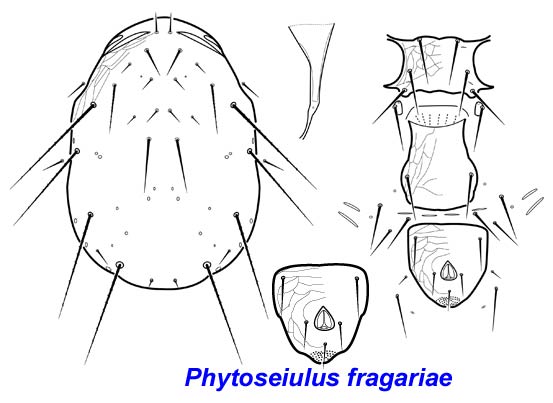Taxonomic Position
Cohort Gamasina
Subcorhort Dermanyssiae
Superfamily Phytoseioidea
Family Phytoseiidae Berlese
Phytoseiulus fragariae Denmark & Schicha
Diagnostic characters of adult female:
-
Dorsal shield ca. 0.320-0.330 mm long
-
Dorsal shield setae j5 and S5 both present, j5 short and not reaching insertion of j6; j6 simple and shorter than Z1; R1 and r3 simple, similar in length.
-
Peritrematal shield fused to dorsal shield anteriorly
-
Fixed digit of chelicera elongate and with row of 7-9 teeth
-
Calyx of spermatheca funnel-shaped
-
Sternal shield with 3 pairs of setae; st4 on small platelets
-
Anal opening on ventrianal shield with 5 setae
-
Setae JV2 on subpentagonal to subcordate ventrianal shield and JV4 in soft cuticle
-
Genu IV with simple macroseta (ca. 0.060 mm long); macroseta on basitarsus IV simple (ca. 0.086 mm long)

Similar species. P. longipes has a sternal shield with only 2 pairs of setae (st1-2) and lacks dorsal shield setae j5 and S5. P. macropilis usually has an irregular ventrianal shield with 4-5 setae (rarely an anal shield with 3 setae), a long and barbed seta j6, and a barbed macroseta on basitarsus IV. P. persimilis has an anal shield with only 3 setae, a long and barbed seta j6, and a barbed macroseta on basitarsus IV. Both P. macropilis and persimilis have vase-shaped spermathecae with distinct necks and basal swellings.
Ecology & Distribution. Phytoseiulus fragariae is known only from Brazil in South America.
References
Denmark HA & Schicha E. 1983. Revision of the genus Phytoseiulus Evans (Acarina: Phytoseiidae). International Journal of Acarology 9: 27-35.
Evans GO. 1958. A new mite of the genus
Phytoseiulus Evans (Acarina: Phytoseiidae) from Southern Rhodesia.
Journal of the Entomological Society of South Africa 21: 306-308.Schicha e.
1987. Phytoseiidae of
Australia and Neighbouring Areas. (Indira Publishing House, Oak Park, Michigan, USA.)
Schuster RO & Pritchard EA. 1963. Phytoseiid mites of California. Hilgardia 43: 191-285.
Takahashi F & Chant DA. 1993. Phylogenetic relationships in the genus Phytoseiulus Evans (Acari: Phytoseiidae). II. Taxonomic Review. International Journal of Acarology 19: 23-37.
Tseng YH. 1976.
Systematics of the mite family Phytoseiidae from Taiwan, with a revised
key to the genera of the world (II). Journal
of the Agricultural Association of China 94: 86-128.